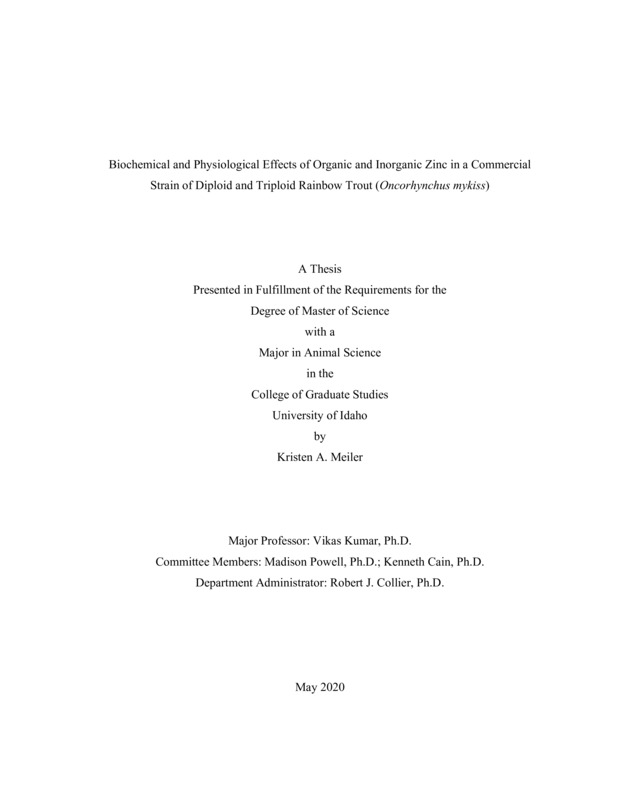Biochemical and Physiological Effects of Organic and Inorganic Zinc in a Commercial Strain of Diploid and Triploid Rainbow Trout (Oncorhynchus mykiss)
Meiler, Kristen Alyssa. (2020-05). Biochemical and Physiological Effects of Organic and Inorganic Zinc in a Commercial Strain of Diploid and Triploid Rainbow Trout (Oncorhynchus mykiss). Theses and Dissertations Collection, University of Idaho Library Digital Collections. https://www.lib.uidaho.edu/digital/etd/items/meiler_idaho_0089n_11818.html
- Title:
- Biochemical and Physiological Effects of Organic and Inorganic Zinc in a Commercial Strain of Diploid and Triploid Rainbow Trout (Oncorhynchus mykiss)
- Author:
- Meiler, Kristen Alyssa
- Date:
- 2020-05
- Program:
- Animal and Veterinary Science
- Subject Category:
- Animal sciences
- Abstract:
-
Zinc is an essential micro-mineral for fin fish and is required for a wide range of physiological functions. Bioavailability of minerals in diets depends on quality and source. Finding chelates that are more bioavailable to fish can help decrease production costs and metal waste pollution. In aquaculture, triploid fish can be utilized for their sterility to decrease risk of genetic pollution and for their potential for faster growth. However, zinc requirements may differ between ploidies due to physiologic differences and to our knowledge there is no information regarding zinc requirements for triploid Rainbow Trout. These experiments aim to determine the effects of supplemental zinc in a commercial strain of genetically similar diploid and triploid Rainbow Trout (Oncorhynchus mykiss, average initial weight: 53.07 ± 4.35g) using various levels (63, 93, 123, 153, 183 mg kg-1 Zn) of both organic and inorganic zinc. A total of 11 diets were formulated to be isonitrogenous (42% crude protein) and isolipidic (21% lipid), and fed in triplicate for 64 days. Results showed that neither ploidy (diploid vs. triploid) nor type of mineral (organic vs. inorganic) significantly influenced the growth performance of fish, distal intestine histology, or cataract formation/lens histology. However, there were significant interactions in nutrient retentions and vertebral zinc content for both ploidies. Additionally, there were significant differences in oxidative stress related gene expression patterns in hepatocytes, supporting evidence for a mechanism of zinc’s role in the antioxidant defense system of Rainbow Trout. Gene expression was generally higher in response to organic zinc in triploids than in diploids, suggesting that diploid and triploid Rainbow Trout have different zinc requirements. These findings also establish a relationship between dietary zinc and the retention of zinc and other macronutrients, such as lipid and protein, and the oxidative stress response in diploid and triploid rainbow trout. Increased supplementation of organic zinc may aid diploid and triploid Rainbow Trout in superior utilization of macronutrients in feed and increased capacity to combat oxidative stress.
- Description:
- masters, M.S., Animal and Veterinary Science -- University of Idaho - College of Graduate Studies, 2020-05
- Major Professor:
- Kumar, Vikas
- Committee:
- Powell, Madison; Cain, Kenneth
- Defense Date:
- 2020-05
- Identifier:
- Meiler_idaho_0089N_11818
- Type:
- Text
- Format Original:
- Format:
- application/pdf
- Rights:
- In Copyright - Educational Use Permitted. For more information, please contact University of Idaho Library Special Collections and Archives Department at libspec@uidaho.edu.
- Standardized Rights:
- http://rightsstatements.org/vocab/InC-EDU/1.0/

